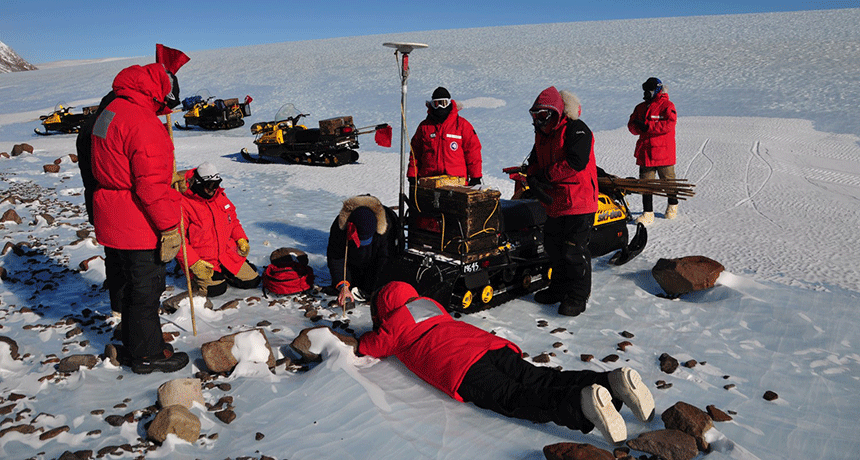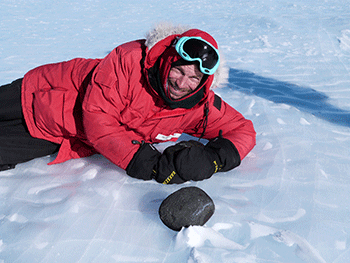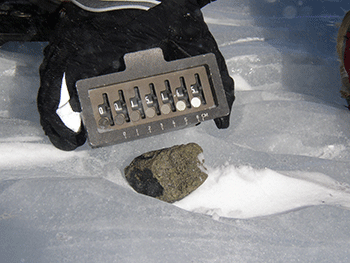Hot on the trail of Antarctic meteorites
Each year, scientists scour the frozen continent for space rocks

Each year, groups of scientists with the Antarctic Search for Meteorites (ANSMET) project spend weeks camping on ice fields in Antarctica. Using snowmobiles, they travel about looking to find and bring back meteorites. Here's a group that has just met with success.
NASA
By Beth Geiger
It’s a clear summer day in the Transantarctic Mountains. Being January, the temperature here in the vast emptiness of Antarctica is a relatively balmy minus 18 degrees Celsius (0 Fahrenheit). Geologist Stanley Love normally works in Houston, Texas. Now he and six others scientists were zipping across the dazzling white ice on snowmobiles. They were loaded with tents, stoves, sleeping bags and food. For the next six weeks, this team would be camping on Earth’s coldest, most hostile continent. Harsh? Absolutely. But it’s the only way to accomplish their mission: finding meteorites.
Meteorites are rocks from space that have crash-landed on Earth. Before they land, they’re called meteors. They can light the sky as “shooting stars.” Once here, they can teach us things we can’t learn from Earth rocks. Many meteorites are old. They date from the early days of our solar system, 4.6 billion years ago. No Earth rocks are that old. Meteorites also can carry clues about where they came from, which might be the moon or Mars. No wonder scientists are in hot pursuit of them.
Plenty of meteors enter Earth’s atmosphere each year. Most burn up. Still, many reach our planet’s surface. Up to 84,000 meteorites bigger than a marble fall to Earth every year.

That’s a lot of meteorites. But most are nearly impossible to find. They may be hidden by plant leaves. Or they might be mixed up with Earth rocks. Or, they might have sunk into deep water. But in the vast emptiness of Antarctica, spotting meteorites can be as easy as black on white. That’s why, for decades, teams of scientists like Love’s have braved Antarctica’s extreme conditions to look for them. A research group called the Antarctic Search for Meteorites, or ANSMET, coordinates these expeditions.
When a meteorite lands in Antarctica, it has already traveled more than 1,600,000 kilometers (about a million miles) through space. Once picked up by scientists like Love, it now begins a new journey. The rocks eventually travel to the Washington, D.C. area. They go to the Smithsonian Institution’s meteorite library. And from there, tiny pieces of the rocks journey all over the world. They are lent to scientists who probe them for clues to Earth’s beginnings — and even hints of alien life.
On the hunt
Out on the ice, Love and his colleagues spot a dark speck. Like hunters on a chase, the team of snowmobile riders swerve toward it.
The rock is about the size of a golf ball. Is it a meteorite? Chances are good. After all, out here, where else would a rock come from but from the sky? Still, the scientists look for surefire clues. The rock is dark and dense. And it has a fusion crust — the melted coating formed by intense heat as it fell though Earth’s atmosphere.

Success! This one is indeed a meteorite.
With the space rock on board, the scientists zoom off again. They’re scanning the vast whiteness as they speed across the snow. Love and his team zip to the next spot. Meanwhile, another ANMSET team has picked up even more meteorites. They label one little rock RBT 04262. RBT stands for Roberts Massif, the area in Antarctica’s Transantarctic Mountains close to where it was found. The 04 identifies the year: 2004. The next three numbers, 262, identify the meteorite as the 262nd to be collected that season.
In an average six-week field season, ANSMET teams will collect 550 meteorites. That’s far more than at any other location on Earth.
“It isn’t just that meteorites are easy to spot here,” says Love. “The flow of the ice can actually concentrate the rocks.” The ice is slowly moving, he explains. The flow can concentrate meteorites in certain places, such as against mountains where old ice is brought to the surface. What’s more, Antarctica’s dry frozen environment keeps them preserved. In addition, the constant winds scour the ice. That can expose meteorites that might have landed hundreds of thousands of years earlier.
Besides being a geologist, Love has another great qualification for an Antarctic meteorite hunter. He’s an astronaut at NASA. He served on NASA training expeditions to practice for the intense conditions in space. (NASA is short for the National Aeronautics and Space Administration.) Then, in 2008 he spent 12 days on a mission to the International Space Station. Such out-of-this-world experiences have surprising similarities to camping on a remote ice sheet. It’s the isolation. Living in seclusion with a small group is a challenge no matter where you are. And in both places, even daily routines can be out-of-this world tough. For example, Love points out, “it’s super hard to take a bath.”

To weather such a trip, whether it’s to Antarctica or space, you need to be even-keeled, he adds, and not easily stressed. Otherwise, “little things can really start to bother you about people,” he says. And, like bathing, there are other parallels between space exploration and camping in Antarctica. In fact, astronauts often go to Antarctica for training before they head into space.
Back on the ice, the meteorite hunt is over. The team returns by plane to McMurdo Station. That’s the U.S research center on the tip of Antarctica’s Ross Island. There, the scientists prepare the meteorites for shipment. Each rock goes in a separate bag, which is kept frozen to keep earthly contaminants away. The meteorites fly, still frozen, to the Johnson Space Center in Houston, Texas. There, NASA geologists classify, weigh and photograph each space rock.
Meanwhile, Love and the other team members can finally take a hot shower and head home. They have no idea what the meteorites they found will reveal. Yet they know it was worth the effort. “Getting those samples is as much trouble as it gets,” Love says. “But they tell us where we come from.”
Out-of-this-world library
From the Johnson Space Center, the meteorites are shipped to one of the world’s largest meteorite libraries. It’s inside the Smithsonian Institution’s Museum Support Center in Suitland, Md. There, geologist Cari Corrigan has been sorting, storing and tracking meteorites since 2008. Corrigan spends her days surrounded by cabinet after cabinet full of meteorite chips. There are around 17,000.
The dime-sized chips are set into thin glass slides or stored in plastic vials. They are housed in a special “clean” room. There, the cabinets are pressurized with nitrogen. This preserves the meteorites by keeping them dry and safe from rusting (due to reactions with oxygen), or from picking up contaminants, such as dust or organic material (like skin). Indeed, to help prevent contamination, Corrigan and her colleagues wear protective gear. (Watch the video below for a tour of Corrigan’s archive of space rocks.)
Corrigan has worked with so many meteorites that geologists even named a space rock after her. It’s called 9924 Corrigan. The rock is currently whizzing around the solar system. But who knows. Maybe someday a chunk of it will land in Antarctica.
Most meteorites got their start as stray chunks that broke off asteroids, Corrigan explains. Many came from the asteroid belt. That’s a zone of space rocks located between the orbits of Mars and Jupiter. The region is full of iron-rich chunks that formed during the beginning of the solar system. But they never became part of a larger planetary body. A few meteorites come from other bodies, notably the moon or Mars. In those cases, the meteorites are bits of rock that were thrown into space by large, crater-forming meteorite impacts.
To identify where a meteorite came from, scientists study the rock’s isotopes. These are forms of the same element that have different numbers of neutrons in the nucleus. Oxygen, for example, can have 16, 17 or 18 neutrons. Meteorites from different places — Mars or the moon, for example — have their own unique ratio of oxygen isotopes. That ratio can tell scientists where the space rock came from.
About 85 percent of the meteorites in Antarctica are a type called ordinary chondrites (KON-drytes). They come from the asteroid belt. They’re interesting because they provide clues to the birth of our solar system. But it’s the other 15 percent of meteorites that really excite scientists. They contain a more unusual mix of ingredients. And, of these meteorites, the most interesting ones are the very, very few — less than one-half of one percent — that come from either Mars or the moon.
One of Corrigan’s roles is to analyze meteorites to identify any unusual characteristics. “If it’s just a run of the mill, out-of-this-world rock, it goes into storage,” she says. But if it is unusual, geologists will want to study it more closely. In those cases, Corrigan, or geologists at Johnson Space Center, create a thin slice that can be analyzed in the laboratory.
RBT 04262 was one of the really unusual meteorites. In 2007, geologists at the Johnson Space Center announced that its composition and oxygen isotope ratio revealed that the rock must have come from Mars. They estimated that it was 225 million years old. The scientists also studied isotopes that showed the rock’s exposure to cosmic rays, a type of radiation found in space. Those data suggest that the meteorite had crashed into Antarctica some 700,000 years ago!
As a meteorite librarian, Corrigan also is in charge of loaning out pieces of meteorites when scientists request it. And once news about an unusual meteorite gets out, those requests come flying in.
Message from Mars?
It’s 2011, and Danny Glavin is crushing it. Crushing a meteorite, that is. Glavin works at NASA’s Goddard Space Flight Center in Greenbelt, Md. He and his colleagues are studying a meteorite chip from Corrigan’s collection. Not just any chip, either. It’s a piece of RBT 04262.
“We’re searching for the chemical building blocks of life,” Glavin says. As an astrobiologist, he looks for any clues to biological activity beyond Earth. He’s particularly interested in organic compounds known as amino acids. They are the building blocks of proteins, and essential to life on Earth. Finding amino acids in an extraterrestrial object could suggest that at least some of the ingredients for life exist beyond Earth.

When Glavin heard that RBT 04262 was from Mars, he couldn’t wait to get his hands on a piece of it. Finally, in 2011, he got a peanut-sized chip. In the lab, he and his colleagues processed the sample as they do every meteorite piece they analyze. First the researchers crush it up in a sterile environment. “No sneezing on it!” he says. Next, they boil the crushed rock in sterile water. “We end up making what we call a meteorite tea,” he explains. “Then, we analyze it using a mass spectrometer.” This instrument can identify which chemical elements are present.
Sure enough, RBT 04262 contained amino acids. “Four stood out,” he recalls. “They were unusual.” Three in particular had properties not typically found in Earthly amino acids. “That was pretty strong evidence that we were looking at extraterrestrial amino acids,” he said. “We think these amino acids are from Mars.”
But Glavin and his team wanted to be sure. “Usually, amino acids are from contamination in Antarctica,” he says. Antarctica may look devoid of life. But there are plenty of living things, including people who could have transferred amino acids to the space rock. If the amino acids turned out to be from Earth, then the meteorite would be what Glavin jokingly calls a meteor-wrong. “We requested another piece [of the rock] and found the same thing,” he says. “We almost didn’t believe it. I was kind of thrilled and scared at the same time.”
By 2012, Glavin and his colleagues were sure enough about their findings to publish them in the journal Meteoritics & Planetary Science. Glavin emphasizes that they haven’t actually found direct evidence of life on Mars. But, in the search for extraterrestrial life, they have discovered something very important. There is a way to create the building blocks of life somewhere other than Earth, they now know.
Current evidence suggests that Mars was inhabitable only until 3.5 billion years ago, Glavin notes. At just over 200 million years old, RBT 04262 is far too young to provide clues that far back. “I would love to find an older rock that was from that time. That would be my dream,” says Glavin. “Who knows, maybe it’s sitting in Antarctica right now, waiting to be collected.”







